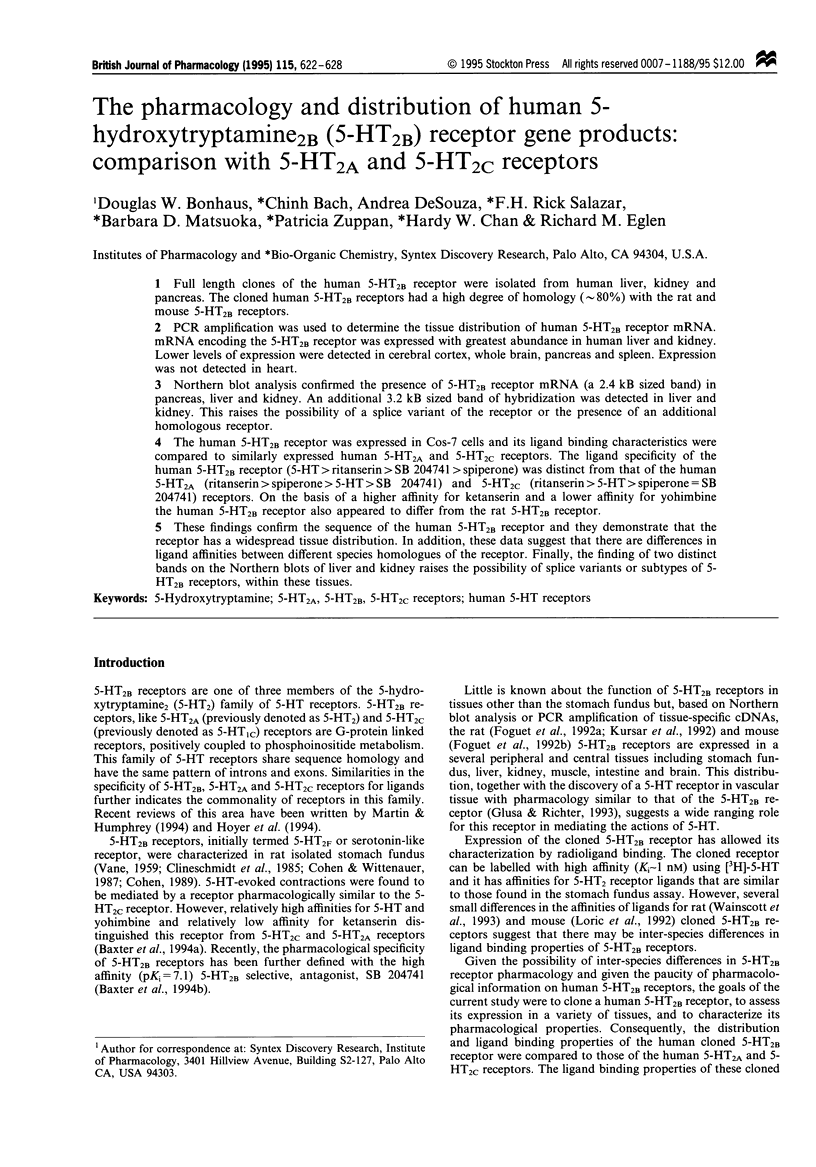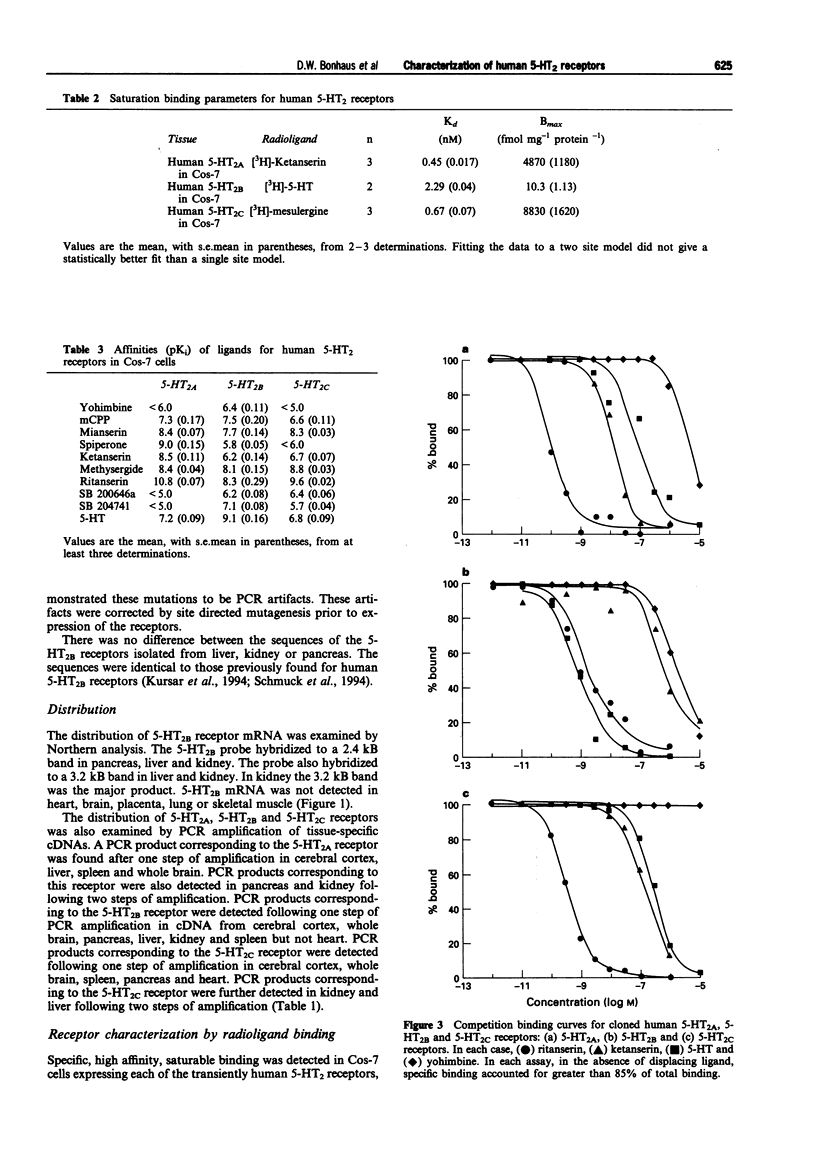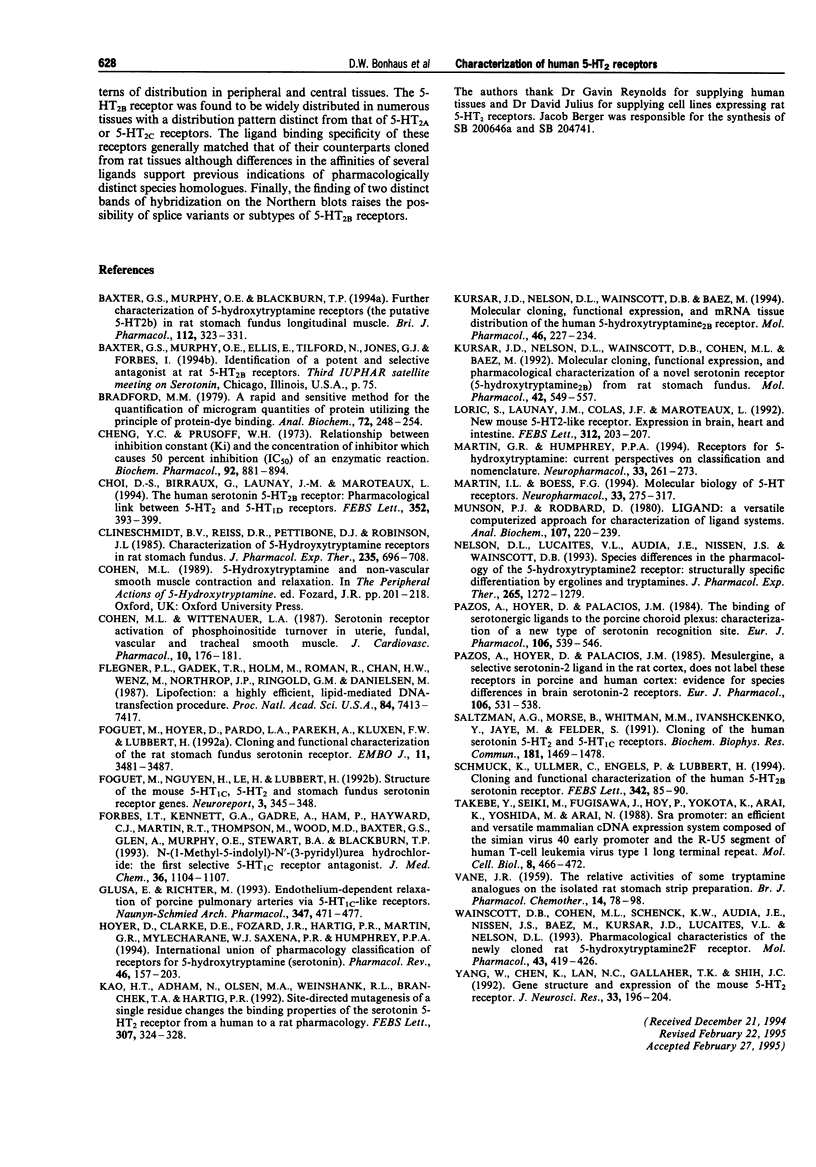Abstract
1. Full length clones of the human 5-HT2B receptor were isolated from human liver, kidney and pancreas. The cloned human 5-HT2B receptors had a high degree of homology (approximately 80%) with the rat and mouse 5-HT2B receptors. 2. PCR amplification was used to determine the tissue distribution of human 5-HT2B receptor mRNA. mRNA encoding the 5-HT2B receptor was expressed with greatest abundance in human liver and kidney. Lower levels of expression were detected in cerebral cortex, whole brain, pancreas and spleen. Expression was not detected in heart. 3. Northern blot analysis confirmed the presence of 5-HT2B receptor mRNA (a 2.4 kB sized band) in pancreas, liver and kidney. An additional 3.2 kB sized band of hybridization was detected in liver and kidney. This raises the possibility of a splice variant of the receptor or the presence of an additional homologous receptor. 4. The human 5-HT2B receptor was expressed in Cos-7 cells and its ligand binding characteristics were compared to similarly expressed human 5-HT2A and 5-HT2C receptors. The ligand specificity of the human 5-HT2B receptor (5-HT > ritanserin > SB 204741 > spiperone) was distinct from that of the human 5-HT2A (ritanserin > spiperone > 5-HT > SB 204741) and 5-HT2C (ritanserin > 5-HT > spiperone = SB 204741) receptors. On the basis of a higher affinity for ketanserin and a lower affinity for yohimbine the human 5-HT2B receptor also appeared to differ from the rat 5-HT2B receptor.(ABSTRACT TRUNCATED AT 250 WORDS)
Full text
PDF






Images in this article
Selected References
These references are in PubMed. This may not be the complete list of references from this article.
- Baxter G. S., Murphy O. E., Blackburn T. P. Further characterization of 5-hydroxytryptamine receptors (putative 5-HT2B) in rat stomach fundus longitudinal muscle. Br J Pharmacol. 1994 May;112(1):323–331. doi: 10.1111/j.1476-5381.1994.tb13072.x. [DOI] [PMC free article] [PubMed] [Google Scholar]
- Boess F. G., Martin I. L. Molecular biology of 5-HT receptors. Neuropharmacology. 1994 Mar-Apr;33(3-4):275–317. doi: 10.1016/0028-3908(94)90059-0. [DOI] [PubMed] [Google Scholar]
- Bradford M. M. A rapid and sensitive method for the quantitation of microgram quantities of protein utilizing the principle of protein-dye binding. Anal Biochem. 1976 May 7;72:248–254. doi: 10.1006/abio.1976.9999. [DOI] [PubMed] [Google Scholar]
- Choi D. S., Birraux G., Launay J. M., Maroteaux L. The human serotonin 5-HT2B receptor: pharmacological link between 5-HT2 and 5-HT1D receptors. FEBS Lett. 1994 Oct 3;352(3):393–399. doi: 10.1016/0014-5793(94)00968-6. [DOI] [PubMed] [Google Scholar]
- Clineschmidt B. V., Reiss D. R., Pettibone D. J., Robinson J. L. Characterization of 5-hydroxytryptamine receptors in rat stomach fundus. J Pharmacol Exp Ther. 1985 Dec;235(3):696–708. [PubMed] [Google Scholar]
- Cohen M. L., Wittenauer L. A. Serotonin receptor activation of phosphoinositide turnover in uterine, fundal, vascular, and tracheal smooth muscle. J Cardiovasc Pharmacol. 1987 Aug;10(2):176–181. doi: 10.1097/00005344-198708000-00007. [DOI] [PubMed] [Google Scholar]
- Felgner P. L., Gadek T. R., Holm M., Roman R., Chan H. W., Wenz M., Northrop J. P., Ringold G. M., Danielsen M. Lipofection: a highly efficient, lipid-mediated DNA-transfection procedure. Proc Natl Acad Sci U S A. 1987 Nov;84(21):7413–7417. doi: 10.1073/pnas.84.21.7413. [DOI] [PMC free article] [PubMed] [Google Scholar]
- Foguet M., Hoyer D., Pardo L. A., Parekh A., Kluxen F. W., Kalkman H. O., Stühmer W., Lübbert H. Cloning and functional characterization of the rat stomach fundus serotonin receptor. EMBO J. 1992 Sep;11(9):3481–3487. doi: 10.1002/j.1460-2075.1992.tb05427.x. [DOI] [PMC free article] [PubMed] [Google Scholar]
- Foguet M., Nguyen H., Le H., Lübbert H. Structure of the mouse 5-HT1C, 5-HT2 and stomach fundus serotonin receptor genes. Neuroreport. 1992 Apr;3(4):345–348. doi: 10.1097/00001756-199204000-00014. [DOI] [PubMed] [Google Scholar]
- Forbes I. T., Kennett G. A., Gadre A., Ham P., Hayward C. J., Martin R. T., Thompson M., Wood M. D., Baxter G. S., Glen A. N-(1-methyl-5-indolyl)-N'-(3-pyridyl)urea hydrochloride: the first selective 5-HT1C receptor antagonist. J Med Chem. 1993 Apr 16;36(8):1104–1107. doi: 10.1021/jm00060a019. [DOI] [PubMed] [Google Scholar]
- Glusa E., Richter M. Endothelium-dependent relaxation of porcine pulmonary arteries via 5-HT1C-like receptors. Naunyn Schmiedebergs Arch Pharmacol. 1993 May;347(5):471–477. doi: 10.1007/BF00166737. [DOI] [PubMed] [Google Scholar]
- Hoyer D., Clarke D. E., Fozard J. R., Hartig P. R., Martin G. R., Mylecharane E. J., Saxena P. R., Humphrey P. P. International Union of Pharmacology classification of receptors for 5-hydroxytryptamine (Serotonin). Pharmacol Rev. 1994 Jun;46(2):157–203. [PubMed] [Google Scholar]
- Kao H. T., Adham N., Olsen M. A., Weinshank R. L., Branchek T. A., Hartig P. R. Site-directed mutagenesis of a single residue changes the binding properties of the serotonin 5-HT2 receptor from a human to a rat pharmacology. FEBS Lett. 1992 Aug 3;307(3):324–328. doi: 10.1016/0014-5793(92)80705-l. [DOI] [PubMed] [Google Scholar]
- Kursar J. D., Nelson D. L., Wainscott D. B., Baez M. Molecular cloning, functional expression, and mRNA tissue distribution of the human 5-hydroxytryptamine2B receptor. Mol Pharmacol. 1994 Aug;46(2):227–234. [PubMed] [Google Scholar]
- Kursar J. D., Nelson D. L., Wainscott D. B., Cohen M. L., Baez M. Molecular cloning, functional expression, and pharmacological characterization of a novel serotonin receptor (5-hydroxytryptamine2F) from rat stomach fundus. Mol Pharmacol. 1992 Oct;42(4):549–557. [PubMed] [Google Scholar]
- Loric S., Launay J. M., Colas J. F., Maroteaux L. New mouse 5-HT2-like receptor. Expression in brain, heart and intestine. FEBS Lett. 1992 Nov 9;312(2-3):203–207. doi: 10.1016/0014-5793(92)80936-b. [DOI] [PubMed] [Google Scholar]
- Martin G. R., Humphrey P. P. Receptors for 5-hydroxytryptamine: current perspectives on classification and nomenclature. Neuropharmacology. 1994 Mar-Apr;33(3-4):261–273. doi: 10.1016/0028-3908(94)90058-2. [DOI] [PubMed] [Google Scholar]
- Munson P. J., Rodbard D. Ligand: a versatile computerized approach for characterization of ligand-binding systems. Anal Biochem. 1980 Sep 1;107(1):220–239. doi: 10.1016/0003-2697(80)90515-1. [DOI] [PubMed] [Google Scholar]
- Nelson D. L., Lucaites V. L., Audia J. E., Nissen J. S., Wainscott D. B. Species differences in the pharmacology of the 5-hydroxytryptamine2 receptor: structurally specific differentiation by ergolines and tryptamines. J Pharmacol Exp Ther. 1993 Jun;265(3):1272–1279. [PubMed] [Google Scholar]
- Pazos A., Hoyer D., Palacios J. M. Mesulergine, a selective serotonin-2 ligand in the rat cortex, does not label these receptors in porcine and human cortex: evidence for species differences in brain serotonin-2 receptors. Eur J Pharmacol. 1984 Nov 27;106(3):531–538. doi: 10.1016/0014-2999(84)90056-6. [DOI] [PubMed] [Google Scholar]
- Pazos A., Hoyer D., Palacios J. M. The binding of serotonergic ligands to the porcine choroid plexus: characterization of a new type of serotonin recognition site. Eur J Pharmacol. 1984 Nov 27;106(3):539–546. doi: 10.1016/0014-2999(84)90057-8. [DOI] [PubMed] [Google Scholar]
- Saltzman A. G., Morse B., Whitman M. M., Ivanshchenko Y., Jaye M., Felder S. Cloning of the human serotonin 5-HT2 and 5-HT1C receptor subtypes. Biochem Biophys Res Commun. 1991 Dec 31;181(3):1469–1478. doi: 10.1016/0006-291x(91)92105-s. [DOI] [PubMed] [Google Scholar]
- Schmuck K., Ullmer C., Engels P., Lübbert H. Cloning and functional characterization of the human 5-HT2B serotonin receptor. FEBS Lett. 1994 Mar 28;342(1):85–90. doi: 10.1016/0014-5793(94)80590-3. [DOI] [PubMed] [Google Scholar]
- Takebe Y., Seiki M., Fujisawa J., Hoy P., Yokota K., Arai K., Yoshida M., Arai N. SR alpha promoter: an efficient and versatile mammalian cDNA expression system composed of the simian virus 40 early promoter and the R-U5 segment of human T-cell leukemia virus type 1 long terminal repeat. Mol Cell Biol. 1988 Jan;8(1):466–472. doi: 10.1128/mcb.8.1.466. [DOI] [PMC free article] [PubMed] [Google Scholar]
- VANE J. R. The relative activities of some tryptamine analogues on the isolated rat stomach strip preparation. Br J Pharmacol Chemother. 1959 Mar;14(1):87–98. doi: 10.1111/j.1476-5381.1959.tb00933.x. [DOI] [PMC free article] [PubMed] [Google Scholar]
- Wainscott D. B., Cohen M. L., Schenck K. W., Audia J. E., Nissen J. S., Baez M., Kursar J. D., Lucaites V. L., Nelson D. L. Pharmacological characteristics of the newly cloned rat 5-hydroxytryptamine2F receptor. Mol Pharmacol. 1993 Mar;43(3):419–426. [PubMed] [Google Scholar]
- Yang W., Chen K., Lan N. C., Gallaher T. K., Shih J. C. Gene structure and expression of the mouse 5-HT2 receptor. J Neurosci Res. 1992 Oct;33(2):196–204. doi: 10.1002/jnr.490330203. [DOI] [PubMed] [Google Scholar]



